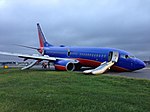United Air Lines Flight 521

United Air Lines Flight 521 was a scheduled passenger flight operated by a Douglas DC-4 from LaGuardia Airport in New York City to Cleveland, Ohio. On May 29, 1947, while attempting to take off on runway 18, the aircraft failed to get airborne, overran the end of the runway, ripped through an airport fence onto traffic on the Grand Central Parkway, and slammed into an embankment, ultimately plunging into a pond and exploding. Ten people escaped the flaming wreckage; only five of them survived.It was the worst commercial aviation disaster in United States history at the time. Its record stood for less than 24 hours before an Eastern Airlines DC-4 crashed near Baltimore, Maryland, killing all 53 aboard.
Excerpt from the Wikipedia article United Air Lines Flight 521 (License: CC BY-SA 3.0, Authors, Images).United Air Lines Flight 521
Runway Drive, New York Queens County
Geographical coordinates (GPS) Address Nearby Places Show on map
Geographical coordinates (GPS)
| Latitude | Longitude |
|---|---|
| N 40.7683 ° | E -73.8847 ° |
Address
Runway Drive
Runway Drive
11371 New York, Queens County
New York, United States
Open on Google Maps







